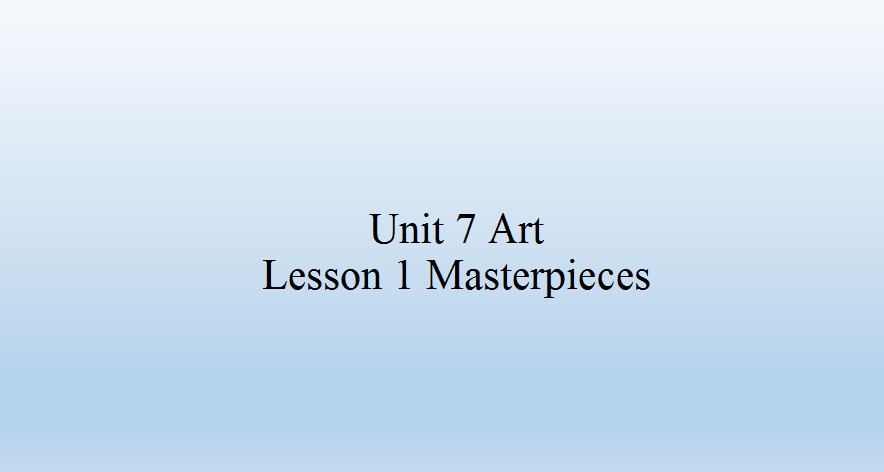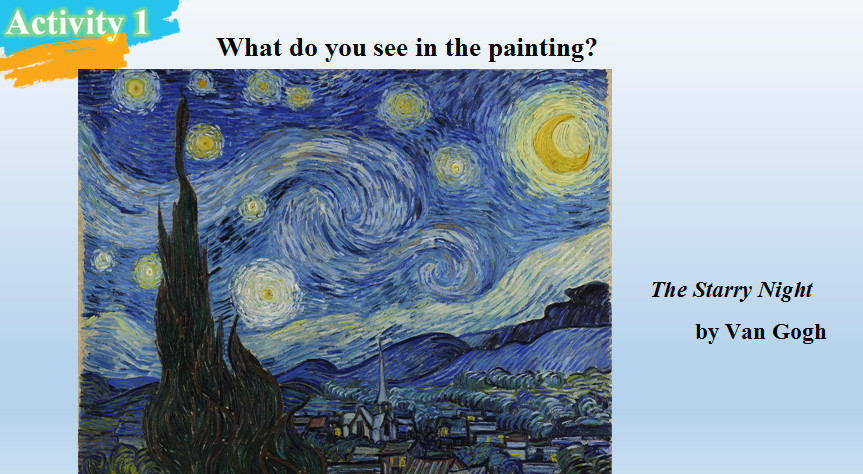



Unit 7 Art
Lesson 1 Masterpieces
【教学目标】
Students will be able to
1. read and talk about paintings and masterpieces
2. read for general understanding
3. read for specific information and understanding words in context
4. read for similarities between three different paintings
5. learn about and practise noun clauses
6. learn about and practise subject clauses, object clauses and predicative clauses
【教学重难点】
1. reading for specific information
2. Using noun clauses in context
【教学过程】
1. Talk about paintings on page 8.
(1) Discuss one painting at a time. Students can use the vocabulary under the paintings. What title would you give to each painting? Write the heading of each painting on the board; “The Starry Night”, “The Scream” and “The Empire of Light”. Ask students:
a. What does the title say about the painting?
b. What elements can be seen in the painting?
c. What is your opinion of the painting? Explain.
d. What emotion does the painting bring to mind?
e. How does the painting make you feel?
(2) As students are talking, write vocabulary words that they mention on the board. Make sure that every student has a chance to answer the questions and take part in the discussion.
2. Read and find out what each painting is about.
(1) In pairs, students read through the descriptions of the three paintings.
(2) Instruct students to underline the title of each painting and the general sentence for each paragraph.
(3) Encourage students to use the context to understand unknown terms.
(4) In small groups, students discuss what each painting is about.
(5) Review the answers as a class.
3. Read again, take notes and talk about each painting.
(1) Read and discuss the diagram:
a. What does the painting show?
b. What may have inspired the painter?
c. What did the artist think, say or write about the painting?
This may be difficult for students but they can use contextual clues.
(2) Allow students time to read the full article again or call on volunteers to read the passage aloud.
(3) In pairs, students complete the diagram. High level students can attempt to complete the diagram independently.
(4) Discuss the answers as a class.
4. Pair Work: Sort and introduce.
(1) Read the phrases aloud. Explain any difficult words.
(2) In pairs, students complete the table while discussing each phrase and why it applies to the painting.
5. Read and find out similarities.
(1) Suggest that students underline and take note of the similarities in each description as they are listening.
(2) Ask students to volunteer to read the first paragraph of each description.
(3) Create a class discussion on the similarities that students noticed. Encourage all students to participate. Students need to explain their opinions.
(1) Discussion questions:
a. What’s your opinion of the three paintings after reading the descriptions?
b. Do you like or dislike them more? Give your reasons.
(2) Instruct students to work independently, to write a few sentences on each painting, expressing their opinion. They can use the following vocabulary words: artistic beauty, originality, emotional, atmosphere, color scheme, dramatic, contrast, highlights, the painting makes me feel uneasy/inspired, dark and troubling, failure, powerful.
7. Group Work: Introduce the paintings.
(1) Divide students into small groups.
(2) Each group chooses one painting and selects one person to be the scribe and write down notes for the group.
(3) Each student in the group describes the painting, and provides background to the painting, the artist, the inspiration behind the painting etc. The scribe can mind map this information.
(4) Each group writes at least ten complete sentences about the painting using these descriptions.
(5) A volunteer from the group reads this passage to the class, role playing that he or she is introducing the painting to visitors at an art gallery.
(6) The class can ask questions about the painting and members from the group can help to answer the questions.
8. Pair Work: Read and answer.
(1) Before starting, revise the different types of noun clauses. Students can read the Grammar Summary for Unit 7, Noun Clauses on page 94. Read through the rules and examples with the class and ensure that students understand clauses in the examples.
(2) Students work in pairs to answer the questions on page 10.
9. Combine two expressions to make a complete sentence.
(1) Divide students into pairs.
(2) Explain to students that full sentences include a subject (noun), a verb and a complete thought. Show that the shorter sentences do not make sense on their own as they are incomplete thoughts. Highlight that short sentences can be full sentences but not always.
(3) Instruct students to read each sentence pair aloud and decide how to join the two expressions using a subject clause, an object clause or a predicative clause. Students need to support their answers.
(4) Students write the completed sentences.
10. Rewrite sentences.
(1) Ask volunteer students to read the passage aloud to the class. Discuss any difficult words and terminology.
Unit 7 Art
Lesson 1 Masterpieces
【学习目标】
You will be able to
1. read and talk about paintings and masterpieces
2. read for general understanding
3. read for specific information and understanding words in context
4. read for similarities between three different paintings
5. learn about and practise noun clauses
6. learn about and practise subject clauses, object clauses and predicative clauses
【学习重难点】
1. reading for specific information
2. Using noun clauses in context
【学习过程】
1. What do you see in the paintings?
2. Read the descriptions and find out what each painting is about.
|
The Starry Night |
The Scream |
The Empire of Light |
|
|
|
|
3. Read again, take notes and talk about each painting.
1. What does the painting show?
2. What may have inspired the painter?
3. What did the artist think or say about the painting?
4. Sort the expression on page 10 and then use them to practice introducing the paintings.
5. After reading the descriptions, do you like or dislike them more? Give your reasons.
|
Vocabulary you might need: artistic beauty originality emotional atmosphere color scheme dramatic contrast highlights the painting makes me feel uneasy/inspired, dark and troubling failure powerful |
6. Group Work: Suppose you are a volunteer at an art exhibition. Introduce one of the three paintings to the visitors.
7. Noun clauses, subject clauses, object clauses, and predicative clauses.
A noun clause is a dependent clause that acts as a noun. Noun clauses can act as subjects, direct objects, indirect objects, predicate nominatives, or objects of a preposition.
Example:
(1) Whichever restaurant you pick is fine with me. (subject—a subject clause)
(2) Do you know what the weather will be like? (direct object—an object clause)
(3) Be sure to send whoever interviewed you a thank-you note. (indirect object—an object clause)
(4) The focus of our work is how we can satisfy customers most effectively. (a predicate nominative—an predicative clause)
(5) It’s important to think about why we make certain decisions. (an object of a preposition—an object clause)
8. Combine the two expressions using a subject clause, an object clause or a predicative clause.
(1) I don’t know
What kind of a battery is this
__________________________________________________________________
(2) Scientists claim
They will cure cancer
__________________________________________________________________
(3) The news has been confirmed
He is still alive
__________________________________________________________________
(4) Our proposal
You should join in
__________________________________________________________________
(5) The only reason for my coining
because I hoped to see you again
__________________________________________________________________
9. Group Work Read the quotes. Discuss the features of good paintings.
A man paints with his brain and not with his hands.
— Michelangelo, an Italian painter
Painting is silent poetry, and poetry is painting that speaks.
— Plutarch, an ancient Greek writer
Good painting is like good cooking; it can be tasted but not explained.
— Maurice de Vlaminck, a French painter



 人教版(2019)高中英语必修一成套PPT课件+教案+练习+作业+期中期末试卷素材汇编
人教版(2019)高中英语必修一成套PPT课件+教案+练习+作业+期中期末试卷素材汇编 资源名称:北师大版(2019)高中英语必修3成套课件+教案+导学案汇编
资源名称:北师大版(2019)高中英语必修3成套课件+教案+导学案汇编







